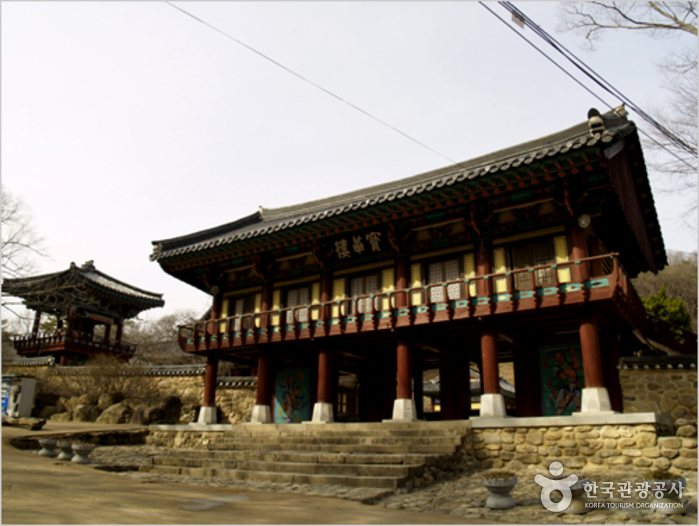Yuksinsa Shrine (육신사)
18.0Km 35480 2024-02-15
64 Yuksinsa-gil, Habin-myeon, Dalseong-gun, Daegu
Yuksinsa Shrine is a revered site dedicated to honoring the Sayuksin. Established during the Joseon dynasty, it stands well-preserved to this day. "Sayuksin" translates to "six dead ministers," referencing the six loyal subjects who, in 1453, attempted to restore King Danjong of the Joseon dynasty but were ultimately captured and executed. The shrine's entrance, marked by the Chungjeolmun Gate, is flanked by long rows of crape myrtle trees. These trees create a stunning visual spectacle when their red flowers are in bloom.
Yongyeonsa Temple (Daegu) (용연사(대구))
18.4Km 42255 2024-02-15
260 Yongyeonsa-gil, Okpo-eup, Dalseong-gun, Daegu
The name Yongyeonsa has its roots in a legend: a dragon is said to have ascended from the pond at the temple's entrance, leading to the name Yongyeon ("yong" means "dragon" and "yeon" means "pond" in Korean). This temple is renowned as one of the sites that enshrine the Buddha's sarira (relics). Inside Yongyeonsa, the ordination platform holds special significance as the resting place of the Buddha's sarira, where rituals are conducted. This symbolizes the enduring presence of the Buddha. The approach to Yongyeonsa Temple is through a forest-rich path, offering an experience akin to a forest bathing. This path also doubles as a hiking trail leading up to Biseulsan Mountain.
Yeongcheon Eunhaesa Temple (은해사 (영천))
18.7Km 14367 2021-12-21
951, Cheongtong-ro, Yeongcheon-si, Gyeongsangbuk-do
+82-54-335-3318
Eunhaesa Temple, located on Palgongsan Mountain in Yeongcheon city, Gyeongsangbuk-do, is one of two major temples on the mountain along with Donghwasa Temple.
The temple was founded by Monk Hyecheol and was given the name Haeansa Temple in the first year of King Heondeok’s reign during the Silla Kingdom (AD 809), but was moved to the current site in the Joseon dynasty in 1546 (the first year of King Myeongjong). Upon its relocation, King Injong of Joseon dynasty was commemorated with a new lecture hall along with a memorial stone plaque where the king's umbilical cord was buried and sealed. It was then when the temple was also given its current name, Eunhaesa Temple.
The temple houses the main shrine, Bohwaru pavilion, Seolseondan Hall, Shimgeondang Hall, eight small hermitages, as well as Baegeungam Temple, Jungangam Temple, and a professional Buddhist education institution, the Eunhaesa Buddhist University. Eunhaesa Temple is home to a National Treasure, Geojoamyongsanjeon Hall, and Treasure, Baekheungamgeukrakjeon Hall. It also contains Treasure, the Sunidan Buddha Platform; Treasure, the Wunbuamcheongdongbosal Seated Buddha Statue; and Treasure, the Eunhaesa Temple Gwaebultaeng hanging Buddha picture. The area is also close to the Seongbu Museum, which exhibits cultural assets from Eunhaesa Temple and the neighboring areas, as well as popular tourist attractions such as Geukrakgul grotto of Jungangam temple (Hwaeomgul Grotto), Geondeul Rock, Manyeonsong Pine Tree, Ganggunsu Waters, and Anheungpokpo Falls of Gigiam Temple.
Hayang Life Sports Park (하양생활체육공원)
19.0Km 0 2024-02-23
33 Yongcheonjebang-gil, Hayang-eup, Gyeongsan-si, Gyeongsangbuk-do
Hayang Life Sports Park was constructed to enhance physical education amenities and offer a relaxation space for residents. It features a football field, futsal court, foot volleyball court, gateball court, and a lawn for relaxation. Additionally, it boasts a floor fountain, a pavilion, a walking trail, and various photo zones. During the summer, a water playground is available. Nearby attractions include Palgongsan Mountain and Daegu Stadium.
St. Mary's Pine Forest Village (성모솔숲마을)
19.1Km 0 2024-02-08
166 Songnae-gil, Gakbuk-myeon, Cheongdo-gun, Gyeongsangbuk-do
St. Mary's Pine Forest Village, a serene retreat house under the Catholic Archdiocese of Daegu, was initially established as a haven for the sick and those seeking spiritual retreats. However, it is now open to all, regardless of their reason for visiting. A mass is celebrated at eleven every morning in the church, welcoming both Catholics and non-Catholics alike. Visitors who are not of the Catholic faith are also encouraged to explore the church, or enjoy a peaceful stroll through the surrounding pine forest. The village comprises several facilities, including the Pine Forest Church, the Way of the Cross, a restaurant, a café, and the Yedam Gallery, which is located within the café.
Dalseong Korea-Japan Friendship Center (달성 한일우호관)
19.2Km 13094 2022-12-29
206, Urok-gil, Dalseong-gun, Daegu
+82-53-659-4490
The Dalseong Korea-Japan Friendship Center opened in 2012 to highlight the philanthropy of General Kim Chung-seon (Japanese name Sayaka, 1571-1642) and promote friendship between Korea and Japan. Kim Chung-seon was a Japanese general who defected to Korea during the Imjin War. Shortly after arriving on Korean soil as a commander of a Japanese army, Kim, together with his soldiers, defected to Korea, a choice that has been traditionally attributed to his respect for Korean culture. He transferred the technology of manufacturing rifles to the Korean army and contributed greatly in battles in Gyeongju and Ulsan.
A great number of tourists visit the center to learn about history, including students and their parents, as well as numerous Japanese tourists who visit to commemorate the spirit of General Kim. The center features exhibition rooms, a 3D theater, a tea ceremony room, relics, manifestations of traditional games in Korea and Japan, documents from Wakayama prefecture in Japan, and a site for experiencing archery, all of which can be utilized free of charge.
Nokdongseowon Confucian Academy (녹동서원)
19.3Km 7699 2024-02-06
218 Urok-gil, Gachang-myeon, Dalseong-gun, Daegu
+82-53-659-4490
Nokdongseowon Confucian Academy was built in 1789 in honor of General Kim Chung-seon (1571-1642), who contributed greatly to Korea's defense during the Imjin War (1592-1598). The academy was shut down in 1868, and reinstated in 1885. Then, in 1971, it was moved to its current location. Today, General Kim's tablet is enshrined in this hall, where a memorial service is held every March. Nearby attractions on the grounds of Nokdongseowon include Nokdongsa Temple, Sunguidang Shrine, Hyangyangmun Gate and memorial stones.


 English
English
 한국어
한국어 日本語
日本語 中文(简体)
中文(简体) Deutsch
Deutsch Français
Français Español
Español Русский
Русский